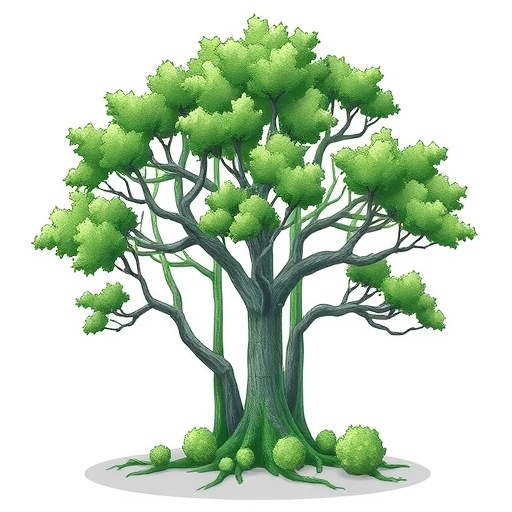In the realm of forestry and ecological research, accurate measurement and estimation of stand volume is pivotal for sustainable forest management and conservation efforts. Recent studies have illuminated the significance of model and form factor determination in estimating stand volumes within natural forest ecosystems and enrichment planting sites. The work of Agbelade A.D. presents groundbreaking insights into methodologies that can refine our understanding of forest volumetrics.
Understanding how forest volume is quantified is critical, not just for timber measurement but also for carbon sequestration assessments and biodiversity evaluations. The model introduced by Agbelade leverages advanced statistical approaches, drawing upon a rich dataset derived from diverse forest types. This model aims to better represent the variability in tree dimensions while also accommodating different growth patterns and environmental conditions.
Stand volume estimation is traditionally fraught with challenges due to the heterogeneity present in forest structures. Trees, often exhibiting varied heights, diameters, and branching architectures, can complicate measurements. Agbelade’s innovative approach addresses these challenges by integrating various forest types into a singular model framework, ensuring that the resultant estimations are both accurate and reliable. The implications of such models extend beyond mere estimation; they inform practices in forest conservation, habitat restoration, and commercial logging efforts, making them invaluable tools for environmental scientists and forestry managers alike.
One notable aspect of Agbelade’s research is the inclusion of enrichment planting sites in the study. These areas, which are designed to enhance biodiversity and ecosystem resilience, present unique challenges when it comes to volume estimation. The conventional metrics often fall short, as they do not adequately account for the specific conditions present in enrichment sites. By examining these areas through a tailored model, Agbelade paves the way for more precise forestry practices that contribute to heightened ecological integrity.
The determination of form factors within the context of stand volume estimation is another critical facet driving Agbelade’s research. Form factors help bridge the gap between measurable tree dimensions and total volume, serving as conversion variables that enhance the calculation process. By developing a model that rigorously analyzes these factors, Agbelade allows for more nuanced estimations that reflect actual growth conditions. This refinement not only improves accuracy but also instills greater confidence in the data collected, enabling researchers to draw more robust conclusions.
Moreover, the methodology proposed by Agbelade emphasizes a multifaceted approach to data collection and analysis. This could involve the use of remote sensing technologies and ground-based surveys that together establish a comprehensive profile of the forest ecosystem. The synergy of these data sources creates a more holistic representation of the landscape, granting researchers deeper insights into the dynamics at play in different forest strata and their respective volumes.
In addition to methodological advancements, Agbelade’s study contributes to the ongoing discourse regarding climate change and its impact on forest ecosystems. As forests play a crucial role in carbon storage, understanding precise volume estimates can directly influence conservation strategies aimed at mitigating climate effects. Consequently, adopting Agbelade’s model could enhance the effectiveness of reforestation and afforestation initiatives, positioning these efforts as critical tools in the fight against global warming.
The commitment to developing innovative methodologies within forestry science signals a broader trend in recognizing the need for precision and adaptability in environmental research. As ecological conditions evolve due to anthropogenic pressures, so must the tools we employ to assess and manage these changes. Incorporating Agbelade’s findings can be seen as an essential step in re-envisioning forest management practices to meet the challenges of the 21st century.
Furthermore, one cannot overlook the socio-economic implications of accurate stand volume estimates. Timber remains a cornerstone of many economies, and better estimation techniques can lead to fairer practices in timber pricing and trade. By refining models to better reflect actual volumes, it becomes feasible to enhance transparency within supply chains, ensuring that both ecological and economic interests are upheld.
The appetite for innovative solutions in forestry management has never been greater, and Agbelade’s research adds a vital piece to the puzzle. With a commitment to operationalizing these findings, forestry professionals can look forward to more effective management practices that not only respect the natural world but also contribute to community livelihoods. The application of accurate stand volume estimation models holds the potential to unlock new opportunities in sustainable forest utilization while fostering greater biodiversity.
As we stand at this junction of technological advancement and ecological necessity, the importance of continual research cannot be overstated. Agbelade A.D.’s contributions to model and form factor determination serve as both an inspiration and a foundation for future studies. With each new finding, the path toward harmonizing human needs with ecological sustainability becomes clearer, revealing a future where forest ecosystems thrive under thoughtful stewardship.
Ultimately, the discourse surrounding stand volume estimation reflects a larger narrative about humanity’s relationship with nature. The question remains not just how we can measure and manage these vital resources but how we can do so in a way that balances economic viability with ecological responsibility. Agbelade’s work stands as a compelling testament to the progress we can achieve through rigorous scientific inquiry and collaboration across disciplines.
Subject of Research: Model and form factor determination for stand volume estimation in natural forest ecosystems and enrichment planting sites.
Article Title: Model and form factor determination for stand volume estimation in natural forest ecosystem and enrichment planting site.
Article References:
Agbelade, A.D. Model and form factor determination for stand volume estimation in natural forest ecosystem and enrichment planting site.
Discov. For. 1, 28 (2025). https://doi.org/10.1007/s44415-025-00027-y
Image Credits: AI Generated
DOI: 10.1007/s44415-025-00027-y
Keywords: Stand volume estimation, forest ecosystems, enrichment planting, model determination, ecological research, form factors.




